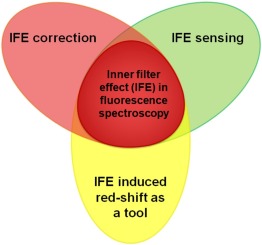Journal of Photochemistry and Photobiology C: Photochemistry Reviews ( IF 12.8 ) Pub Date : 2019-09-14 , DOI: 10.1016/j.jphotochemrev.2019.100318 Suraj Kumar Panigrahi , Ashok Kumar Mishra

|
This article discusses three aspects of inner filter effect (IFE) in fluorescence spectroscopy. (i) First, IFE as undesirable in fluorescence measurements: IFE results in non-linear fluorescence response of the analyte under study and it has been verified that IFE cannot be eliminated; it can either be minimized or corrected for intensity loss. Over the years, researchers have proposed many intensity correction methods to avoid IFE related issues. Often analysts using fluorescence spectroscopy, knowingly or unknowingly, ignore IFE or use an inappropriate intensity correction method. Herein, we have highlighted the basis and significances of various correction models that are proposed since 1970s to till date. (ii) Second, IFE mediated concentration dependent red shift (CDRS) as an analytical tool: the conventional fluorescence measurements and IFE correction strategies cannot be applied in analysis of optically dense multi-fluorophoric samples like oils, petrochemicals, biological samples and food samples etc. The strategy for exclusive inclusion of IFE and IFE induced CDRS as characteristics of the system for development of fluorescence based assay, towards maximizing fluorescence sensitivity of optically dense multi-fluorophoric systems, have been discussed. (iii) Third, IFE based sensing: when the sample contains chromophores, which absorb either at the excitation or at the emission wavelength range of the fluorophore, then the chromophores act as a filter. Thus tuning either the absorber or fluorophore concentration will lead to development of fluorescence based assay for a selective analyte. Principles and protocols are described to identify whether a sensing event is due to IFE or any other fluorescence mechanism. Additionally, a brief description is given on advanced findings and progresses made in sensing of for various classes of analytes in the recent past, using IFE concept. The second and third aspect combined together serve as a tool towards enhancing sensitivity of fluorescence measurement.
中文翻译:

荧光光谱中的内部滤光片效应:作为问题和解决方案
本文讨论了荧光光谱学中内部过滤器效应(IFE)的三个方面。(i)首先,IFE在荧光测量中是不可取的:IFE导致所研究分析物的非线性荧光响应,并且已证实不能消除IFE;可以将其最小化或针对强度损失进行校正。多年来,研究人员提出了许多强度校正方法来避免与IFE相关的问题。通常,使用荧光光谱法的分析人员有意或无意地忽略了IFE或使用了不合适的强度校正方法。在此,我们重点介绍了自1970年代至今提出的各种校正模型的基础和重要性。(ii)其次,IFE介导的浓度依赖性红移(CDRS)作为分析工具:常规的荧光测量和IFE校正策略不能用于分析光密性多荧光团样品,例如油,石化产品,生物样品和食品样品等。IFE和IFE诱导的CDRS独家纳入的策略是开发系统的特征已经讨论了基于荧光的测定的方法,其旨在最大化光学密集的多荧光团系统的荧光灵敏度。(iii)第三,基于IFE的传感:当样品中包含在荧光团的激发波长或发射波长范围吸收的发色团时,发色团将充当过滤器。因此,调节吸收剂或荧光团的浓度将导致针对选择性分析物的基于荧光的测定法的发展。描述原理和协议以识别感测事件是由于IFE还是任何其他荧光机制引起的。另外,简要介绍了使用IFE概念在感测各种近级分析物方面的最新发现和进展。结合在一起的第二方面和第三方面用作增强荧光测量灵敏度的工具。











































 京公网安备 11010802027423号
京公网安备 11010802027423号